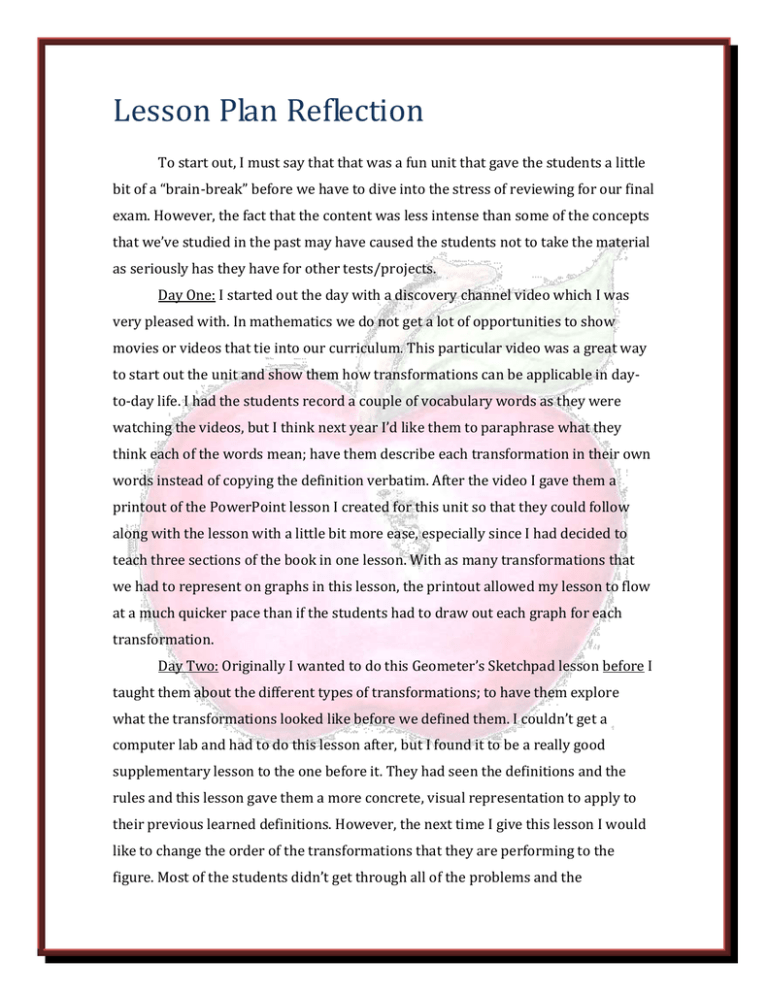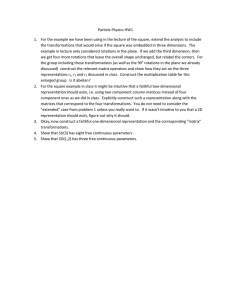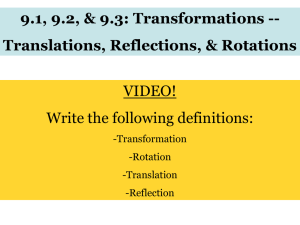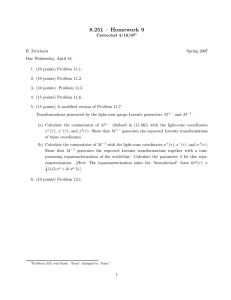Lesson Plan Reflection
advertisement

Lesson Plan Reflection To start out, I must say that that was a fun unit that gave the students a little bit of a “brain-break” before we have to dive into the stress of reviewing for our final exam. However, the fact that the content was less intense than some of the concepts that we’ve studied in the past may have caused the students not to take the material as seriously has they have for other tests/projects. Day One: I started out the day with a discovery channel video which I was very pleased with. In mathematics we do not get a lot of opportunities to show movies or videos that tie into our curriculum. This particular video was a great way to start out the unit and show them how transformations can be applicable in dayto-day life. I had the students record a couple of vocabulary words as they were watching the videos, but I think next year I’d like them to paraphrase what they think each of the words mean; have them describe each transformation in their own words instead of copying the definition verbatim. After the video I gave them a printout of the PowerPoint lesson I created for this unit so that they could follow along with the lesson with a little bit more ease, especially since I had decided to teach three sections of the book in one lesson. With as many transformations that we had to represent on graphs in this lesson, the printout allowed my lesson to flow at a much quicker pace than if the students had to draw out each graph for each transformation. Day Two: Originally I wanted to do this Geometer’s Sketchpad lesson before I taught them about the different types of transformations; to have them explore what the transformations looked like before we defined them. I couldn’t get a computer lab and had to do this lesson after, but I found it to be a really good supplementary lesson to the one before it. They had seen the definitions and the rules and this lesson gave them a more concrete, visual representation to apply to their previous learned definitions. However, the next time I give this lesson I would like to change the order of the transformations that they are performing to the figure. Most of the students didn’t get through all of the problems and the transformations that are the hardest for them to remember/apply are the rotations. As the lesson is now the rotations are towards the end so many of the students didn’t get an opportunity to explore them. I’d like to move the rotations more towards the beginning of the assignment and move a couple of the reflection problems towards the end; they serve more as extension problems rather than essential learnings. I would also ask them to write down the coordinates of the original image before they start so that it is easier for them to compare to the coordinates of the new image to write the rules. Day Three: I think this part of the lesson went very smoothly and was easy to implement on a Monday. Next year I would like to assign them more homework problems that have a fraction as their scale factor. Students are typically “scared” of fractions and with a unit that is generally pretty simple, it would be good to put in some fraction problems to review the basic math skills that sometimes get lost among the more challenging math problems that are included in the high school curriculum. Day Four: I loved this mini dilation project. It was a perfect way for them to practice and reinforce the applications of dilations to individual points and see how it effects the big picture. Plus they had fun with it too! Day Five: Initially I thought that this section would be the easiest for the students because they did really well with the translations lesson and the reflections lesson. This lesson is on “glide reflections” which is a combination of the two. Curiously the name “glide reflections” really seemed to stump them. Next year I’d like to take a little bit more time to have them practice a few problems before I assign them their homework problems. I think we’d still have time to do the kaleidoscope activity, which was really fun for them; we don’t get to use computers very often for our class. Day Six: This was a fun way to wrap up the unit! All of the students made their own tessellation, which could also be used for their quilt project if they decided to use it. There were a lot of really cool designs!







